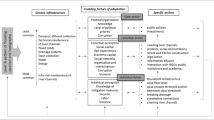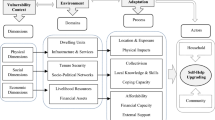Abstract
Megacities in developing countries are rapidly transforming places. Under the impetus of global change processes and consequent transformations at the environmental, social, cultural, political and economical scales; factors causing disasters and losses are changing every day. These changes are also altering society’s ability to respond to hazard events. This paper examines the response of slum dwellers who are the most vulnerable and marginal section of urban population and often located in places with high hazard risk with less or no means to reduce the impact of flood events. Marginal population groups in megacities suffer the negative consequences of large scale global change processes and do not benefit from the risk mitigation strategies adopted by city authorities. The paper therefore argues that people living in informal settlements instead have to employ a combination of structural means and complex networks of assistance to recover from floods. Based on the results deduced from data collected with the help of household surveys in the slums of Mumbai, the study demonstrates the types of coping strategies used by slum dwellers and the changing characteristics of these mechanisms under the influence of global change processes in megacities. Furthermore, results show that capacity to respond is not equally distributed among slum dwellers due to underlying socio cultural divisions and emerging economic and political constraints. The paper concludes that to address existing discrepancies in urban societies and within slum settlements, flood mitigation strategies will have to be (1) more inclusive of marginal population (2) sensitive to the limitations and scope of old and new social structures and (3) incorporate innovative networks of support to deal with the consequences of global change.



Similar content being viewed by others
Notes
Page 359 -IPCC 2007b. Industry, Settlement and Society. In Climate Change 2007: Impacts, Adaptation and Vulnerability: Contribution of Working Group II to the Fourth Assessment Report of the Intergovernmental Panel on Climate Change, ed. M. L. Parry, O F Canziani, J P Palutikof, P J Van Der Linden and C E Hanson 976. Cambridge: Cambridge University Press.
‘When persistent damage to human settlements does not provoke their abandonment or relocation and the inhabitants therefore cohabit with damage and rebuild or repair it whenever possible.’ Page 56 Alexander 2000. Confronting Catastrophe. New York: Oxford University Press.
References
Alexander C (1978) A city is not a tree. In: Kaplan SKaR (ed) Humanscape: Environments for people. Duxbury, Massachusetts, pp 377–401
Alexander D (2000) Confronting catastrophe. Oxford University Press, New York
Amendola AJL-B, Okada N, Shi P (2008) Towards integrated disaster risk management: case studies and trends from asia. Nat Hazards 44:163–168
Aragon-Durand F (2007) Urbanization and flood vulnerability in the peri urban interface of Mexico City. Disasters 31:477–494
Arunachalam, B. (2005). Drainage problems of Brihan Mumbai. Economic Political Weekly, September 3
Bendimerad F, Fernandez J, Reyes M (2008) Enhancing city-to-city sharing and social participation in disaster risk reduction earthquakes and megacities initiatives
Bigio AG (2003) Cities and climate change. In: Kreimer A, Arnold M, Carlin A (eds) Building safer cities. World Bank, Washington DC, pp 91–99
Bohle H-G (2001) Vulnerability and criticality International Human Dimensions Programme on Global Environmental Change Update, 2001
Bombay Community Public Trust (2003) Posha Nakhwa municipal school: Profile of the community. Bombay Community Public Trust, Mumbai
Census of India (2001a) District-specific literates and literacy rates. Government of India
Census of India (2001b) Population trends - 2001. Census of India
Census of India (2001c) Provisional tables. Literary Rate. GOvernment of India
Chatterjee M (2008) Shifting vulnerabilities: a study in flood affected slums of Mumbai. UNU Source 10:100–109
Chen L-C, Liu Y-C, Chan K-C (2006) Integrated community based disaster management program in Taiwan: a case study of Shang- An village. Nat Hazards 37:209–223
Concerned Citizen’s Commission (2005a). Mumbai marooned: an enquiry into Mumbai floods—An executive summary. Mumbai
Concerned Citizen’s Commission (2005b). Mumbai marooned: an enquiry into the Mumbai floods, 2005 Full Report. Mumbai, Conservation Action Trust: 115. http://cat.org.in/index.php/site/article/concerned-citizens-commission-an-enquiry-into-mumbais-floods-2005/
Cybriwsky R (2001) City profile: Jakarta. Cities 18:199–210
Das PK (2003) Slums: The continuing struggle for housing. In: Patel S, Masselos J (eds) Bombay and Mumbai: The City in transition. Oxford University Press, Bombay, pp 207–234
Davis M (2004) Planet of slums—Urban involution and the informal proletariat. New Left Review 5–34
Dutt AK, Noble AG, Venugopal G, Subbiah S (eds) (2003) Challenges to Asian urbanization in the 21st century. Kluwer Academic, Netherlands
Erdik M, Durukal E (2008) Earthquake and its mitigation in Istanbul. Nat Hazards 44:181–197
Faisal IM, Kabir MR, Nishat A (2003) The Disastrous flood of 1998 and long term mitigation strategies for Dhaka City. Nat Hazards 28:85–99
Fernandez JSM, Bendimerad F, Cardona OD (2006) Application of indicators in urban and megacities disaster risk management: a case study of Metro Manila. Earthquakes and Megacities Initiatives
Ghafory-Ashtiany M, Hosseini M (2008) Post BAM recovery and reconstruction. Nat Hazards 44:229–241
Gilbert A (2005) The challenge of slums: global report on human settlements 2003. Prog Hum Geogr 29:118–120
Government of Maharashtra, I (2005) Maharashtra floods 2005. 17. Government of Maharashtra, Mumbai
Gulis GM, Mulumba JAA, Juma O, Kakosova B (2004) Health status of people of slums in Nairobi, Kenya. Environ Res 96:219–227
Gulkan P (2002) Setting the stage for urban risk mitigation: seismic risks and compulsory insurance policy issues in Turkey. In Second Annual IIASA-DPRI Meeting Laxenburg, Austria
Gupta K (2007) Urban flood resilience planning and management and lessons for the future: a case study of Mumbai, India. Urban Water J 4:183–194
Haque CE, Etkin D (2007) People and community as constituent parts of hazards: the significance of societal dimensions in hazards analysis. Nat Hazards 41:271–282
Hardoy JE, Mitlin D, Satterthwaite D (2001) Environmental problems in an urbanizing world. Earthscan, London
Huq S, Alam M (2003) Flood management and vulnerability of Dhaka City. In: Kreimer A, Arnold M, Carlin A (eds) Building safer cities. World Bank, Washington DC, pp 121–135
IHDP (2005) Science plan: Urbanization and global environment change. International Human Dimensions Programme on Global Environmental Change, Bonn
IPCC (2007a) Climate change 2007: Synthesis teport: Contribution of Working Groups I, II and III to the Fourth Assessment Report of the Intergovernmental Panel on Climate Change. ed. R. K. a. A. R. Pachauri, 104. Geneva, Switzerland: IPCC
IPCC (2007b) Industry, settlement and society. In: Parry ML, Canziani OF, Palutikof JP, Van Der Linden PJ, Hanson CE (eds) climate change 2007: impacts, adaptation and vulnerability: Contribution of Working Group II to the fourth assessment report of the intergovernmental panel on climate change. Cambridge University Press, Cambridge, p 976
Jones B (2004) The geography of vulnerability: Who is at risk to multiple hazards in greater Vancouver, British Columbia, Canada? University of Waterloo (Canada), Canada
Khan MR, Rahman MA (2007) Partnership approach to disaster management in Bangladesh: a critical policy assessment. Nat Hazards 41
Kraas F (2007) Megacities and global change: key priorities. The Geographical Journal 173:79–82
Liu J-T, Hammitt JK (1999) Perceived risk and value of workplace safety in a developing country. Journal of Risk Research, Journal of Risk Research J1 - Journal of Risk Research 2:263–275
Manuta J, Lebel L (2005) Climate change and the risks of flood disasters in Asia: Crafting adaptive and just institutions. Unit for Social and Environmental Research, Thailand
Marcuse P, Van Kempen R (2000) Globalizing cities: A new spatial order. Blackwell Publishing Professional
McGranahan GPJ, Songsore J, Surjadi C, Kjellen M (2001) The citizen at risk. Earthscan, London
Mills E (2005) Insurance in a climate of change. Science 309:1040–1046
Mitchell JK (1999) Crucibles of hazard: Mega-cities and disasters in transition. United Nations University Press, Tokyo
Mitchell JK (2005) Urban disasters as indicators of global environmental change: Assessing functional varieties of urban vulnerability. In: System E (ed) Science in the anthropocene. Springer-Verlag, Berlin, pp 132–152
MMRDA (1996) Mumbai Regional Plan Document MMRDA
MMRDA (1998) Mumbai disaster management plan. MMRDA, Mumbai
Muller M (2007) Adapting to climate change: water management for urban resilience. Environ Urban 19:99–113
Neekhra V (2008) Growing vulnerability crisis “ Will slums ever reduce or improve?”. In: Kidokoro T, Okata J, Matasumura S, Shima N (eds) Vulnerable cities: Realities, innovations and strategies. Springer, Tokyo, pp 77–104
O’Hare G, Abbott D, Barke M (1998) A review of slum housing policies in Mumbai. Cities 15:269–283
Pacific Disaster Center (2005) Metropolitan Manila, The Philippines disaster risk management profile. Pacific Disaster Center and Earthquake and Megacities Initiatives
Pacific Disaster Center (2006) Dhaka, Bangladesh Disaster Risk Manangement Profile. Pacific Disaster Center and Earthquake and Megacities Initiatives
Pearce L (2003) Disaster management and community planning, and public participation: how to achieve sustainable hazard mitigation. Nat Hazards 28:211–228
Pelling M (2003) The vulnerability of cities- natural disasters and social resilience. Earthscan, London
Planning Commission I (1951) First five year plan. Government of India, New Delhi
Pryer JA (2003) Poverty and vulnerability in Dhaka slums: The urban livelihoods study. Ashgate UK
Quarantelli EL (2001) Urban vulnerability to disasters in developing countries: managing risks. In Disaster Research Center, 25. Newark: University of Delaware
Tyner JA (2000) Global cities and circuits of global labor: the case of Manila, Philippines. Prof Geogr 52:61–74
Uitto JI (1998) The geography of disaster vulnerability in megacities: a theoretical framework. Appl Geogr 18:7–16
UN - Habitat (2006) State of the World’s Cities Nairobi: United Nations Human Settlements Programme
Waley P (2005) The vulnerability of cities: natural disasters and social resilience. Geogr J 171:190–191
Wang J-a, Shi P-j, Yi X-s, Jia H-c, Zhu L-y (2008) The Regionalization of Urban disasters in China. Natural Hazards 44:169–179
Wenzel FFB, Bendimerad F, Sinha R (2007) Megacities-megarisks. Nat Hazards 42:481–491
Winayanti L, Lang HC (2004) Provision of urban services in an informal settlement: a case study of Kampung Penas Tanggul, Jakarta. Habitat Int 28:41–65
Wisner B (1998) Marginality and vulnerability: why the homeless of Tokyo don’t ‘count’ in disaster preparations. Appl Geogr 18:25–33
Wisner B (2002) Disaster risk reduction in megacities: Making the most of human and social capital. In: Kreimier A, Arnold M, Carlin A (eds) Building safer cities. World Bank, Washington DC
Wisner B, Blaikie P, Cannon T, Davis I (2004) At risk: Natural hazards, people’s vulnerability and disasters. Routledge, New York
Yucemen MS (2005) Probabilistic assessment of earthquake insurance rates for Turkey. Nat Hazards 35:291–313
Acknowledgements
The author would like to thank Robin Leichenko and James K. Mitchell for their suggestions on previous drafts and the two anonymous reviewers for their constructive comments.
Author information
Authors and Affiliations
Corresponding author
Rights and permissions
About this article
Cite this article
Chatterjee, M. Slum dwellers response to flooding events in the megacities of India. Mitig Adapt Strateg Glob Change 15, 337–353 (2010). https://doi.org/10.1007/s11027-010-9221-6
Received:
Accepted:
Published:
Issue Date:
DOI: https://doi.org/10.1007/s11027-010-9221-6




